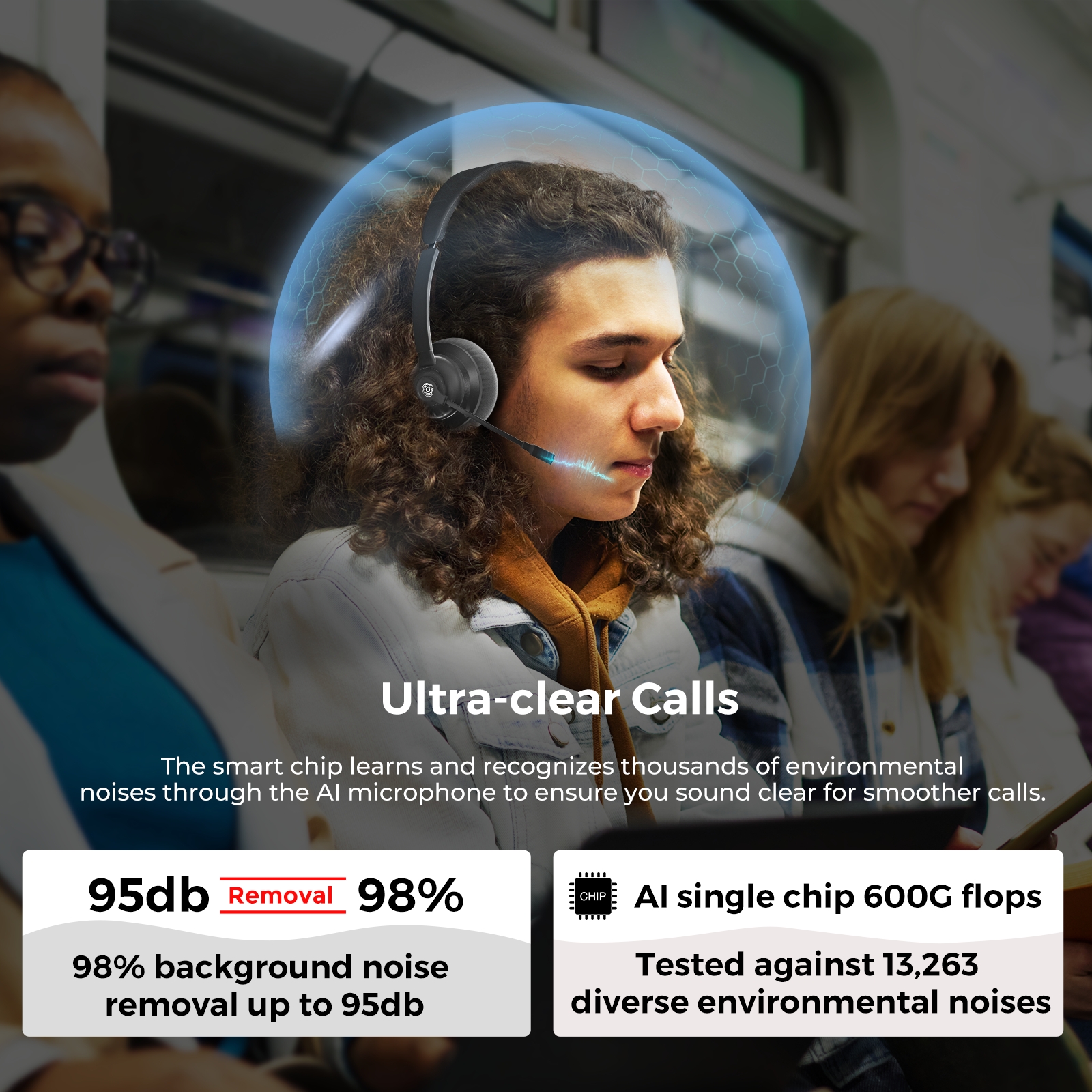How Sales Agents Build Stronger Client Connections with a Headset for Cold Calling
Nothing is more draining for a sales agent than spending hours on cold calling only to have prospects hang up because they can’t hear clearly or you’re battling office noise. Poor audio can ruin even the most polished pitch, causing frustration for both the agent and the prospect. Investing in a headset for cold calling ensures every word is heard, making it clear why cold calling needs a headset, and allowing agents to focus on building genuine client relationships instead of struggling to be understood.
In this blog, we’ll explore the modern cold calling process, the challenges agents face, and how the right headset can help sales teams connect with clients more effectively.
What Is Cold Calling and Why It Matters
%20(1).jpg)
What is Cold Calling?
Cold calling is the practice of reaching out directly to potential clients who have had no prior interaction with your business. It’s a proactive outbound sales strategy where agents initiate contact by phone to generate leads, qualify prospects, and open opportunities for further engagement. In sales, call clarity isn’t just an advantage, it can make or break a deal. It often takes up to 8 cold call attempts to reach a prospect, and with success rates hovering around just 2–2.3%, every word you say counts. While some may view it as outdated, modern cold calling is often highly targeted, relying on research and strategy to make each call more relevant.
Why Cold Calling Matters
Despite the rise of email, social media, and automated outreach, cold calling remains a critical tool for sales agents. It allows for immediate interaction, real-time feedback, and the ability to adapt the conversation based on the prospect’s responses. This personal connection helps agents uncover opportunities, build trust, and lay the foundation for long-term client relationships.
Challenges Sales Agents Face During Cold Calling

While cold calling remains a fundamental component of sales outreach, it presents several challenges that can hinder effectiveness and productivity. Understanding these obstacles is essential for sales agents seeking to optimize their approach and achieve better results.
Common Challenges:
- Low Response Rates: A significant number of prospects either do not answer or terminate calls prematurely, reducing the overall efficiency of outreach efforts.
- Unqualified Leads: Without precise targeting, agents may spend time contacting individuals who lack decision-making authority or genuine interest.
- High Rejection Rate: Frequent negative responses can impact morale and diminish confidence, especially during prolonged calling sessions.
- Time-Intensive Process: Effective cold calling requires thorough research, multiple follow-ups, and careful scheduling, making it a resource-heavy activity.
- Environmental Distractions: Background noise, office activity, or remote work interruptions can compromise concentration and the clarity of communication.
By acknowledging and addressing these challenges, sales agents can implement strategies to improve call effectiveness, maintain consistency, and increase the likelihood of developing meaningful client relationships.
How Noise-Cancelling Headsets Improve Sales Calls

One of the most overlooked factors in successful cold calling is audio quality. Background noise, muffled voices, and poor connection clarity can make even the best pitch ineffective. Using a headset for cold calling addresses these issues by delivering crisp, uninterrupted audio, allowing both the sales agent and prospect to communicate clearly.
Key benefits include:
- Clear Voice Transmission: Ensures your message is heard accurately and professionally.
- Focus and Productivity: Noise-cancelling features allow agents to concentrate on the conversation.
- Enhanced Confidence: Clear communication allows agents to engage prospects with authority and professionalism.
- Sustained Comfort: Ergonomic designs support long calling sessions without fatigue.
- Investing in a quality cold calling sales headset not only improves performance but also demonstrates why cold calling needs a headset for consistent, high-quality client engagement.
Best Headsets for Cold Calling
When choosing a headset for cold calling, the most important factors are voice clarity, noise suppression, and durability because every call matters. Rather than listing many options, here’s a top recommendation that strikes an excellent balance between performance, comfort, and affordability:
Coolpo Ignite Headset
- AI Noise-Canceling Microphone - The Ignite features Coolpo’s MeetingFlex AI technology, which filters out background noise so that your voice comes through crisply and cleanly.
- Flexible Connectivity - It supports plug-and-play USB, multi-point Bluetooth, and even comes with a USB Bluetooth adapter — making it easy to switch between devices.
- Long Battery Life - You get up to 40 hours of usage (for music) and around 7 hours when the AI noise-canceling is enabled.
- Comfort for Long Calls - Soft leather ear pads and a lightweight, ergonomic design let you wear it all day without fatigue.
- Smart Controls - Muting is easy: just lift the mic boom to mute. The AI noise-canceling can be toggled with a double tap; it announces “MeetingFlex On / Off” so you know when it's active.
- Dual Device Connectivity - Connect to two devices at once (e.g., your phone and laptop), which is handy during fast-paced selling environments.
- On-the-Go Usability - It’s designed to be used even while charging, so you don’t need to pause calls to power up.
Why This Beats Many Traditional Business Headsets
- Affordable Yet Powerful: Compared to high-end business headsets, the Ignite offers very good mic noise cancellation and call clarity for a lower price.
- AI-Driven Simplicity: The built-in AI handles noise filtering automatically, making it easy for any sales agent — no need for external noise cancellation software.
- Built for Real-World Use: The combination of long battery life, physical mute functionality, and dual connectivity makes the Ignite extremely practical for cold calling teams.
The Cold Calling Process: How Top Sales Agents Connect with Clients
A successful cold calling strategy isn’t just about dialing numbers, it’s about planning, research, and meaningful engagement. Following a structured process helps sales agents maximize results, build rapport, and increase the likelihood of converting prospects into clients.
Step-by-Step Process:
- Define Clear Objectives Before placing the call, determine what you want to achieve, such as booking a meeting, qualifying a lead, or gathering information. Clear objectives help guide the conversation and ensure each call has purpose.
- Research Your Prospect Understand your contact’s role, company, and potential challenges before calling. Doing so allows you to tailor your approach, making the conversation more relevant and engaging.
- Craft a Flexible Script Prepare a concise introduction and value proposition while allowing room for natural dialogue. A flexible script ensures you stay on track without sounding robotic or rehearsed.
- Engage with Thoughtful Questions Ask open-ended questions to uncover pain points and needs. This helps you listen actively and position your product or service effectively.
- Handle Objections Gracefully Anticipate common objections and respond empathetically. A tactful approach can turn resistance into opportunity and maintain a positive rapport.
- Close or Plan the Next Step If the prospect shows interest, propose a clear next action, such as a follow-up call, demo, or meeting. If not, politely schedule a future check-in or request a referral.
- Review and Refine Your Calls After each call, analyze performance and identify areas for improvement. Continuous reflection helps optimize scripts, timing, and overall approach for better results.
Following this structured cold calling process allows agents to approach each call with strategy and confidence. Consistent preparation, active listening, and refinement help transform cold outreach into meaningful client engagement.
Is Cold Calling Dead in 2026? 5 Reasons Why Not
Every year, the question resurfaces: Is cold calling finally dead? But despite shifts in buyer behavior and the rise of digital channels, cold calling continues to prove its value, especially this coming 2026. Top-performing sales reps are still achieving strong connection rates by removing bad numbers, refining their call cadence, and reaching prospects at optimal times. These high performers also book meetings at significantly higher rates than the average rep, demonstrating that cold calling succeeds when backed by skill and strategy.
Cold calling has also become an effective amplifier for other channels. When prospects receive a call before an email, reply rates increase because the outreach feels more familiar and personalized. Additionally, many sales teams report that cold calls still generate more revenue than email or LinkedIn outreach, especially in industries requiring trust and personalized interaction. New technology continues to push cold calling forward — with tools improving predictive dialing, list hygiene, and real-time insights — making the process more efficient and scalable than ever.
In short, cold calling is not dead in 2026. It has simply evolved into a more targeted, data-driven practice that remains essential for building relationships, validating opportunities, and driving meaningful sales conversations.
Conclusion
Clear communication is the foundation of successful cold calling and real estate sales. From reducing misunderstandings to building stronger client relationships, the right audio setup can make every conversation more productive. By choosing tools that enhance call clarity, provide comfort during long hours, and support seamless multitasking, agents can focus on what matters most: closing deals.
If you’re looking for a headset that delivers reliable noise cancellation, long battery life, and all-day comfort, the Coolpo Ignite Headset stands out as a practical, high-performance choice. With AI-powered features designed for real work environments, it helps real estate professionals stay confident, heard, and fully equipped to turn every call into an opportunity.





.jpg)



